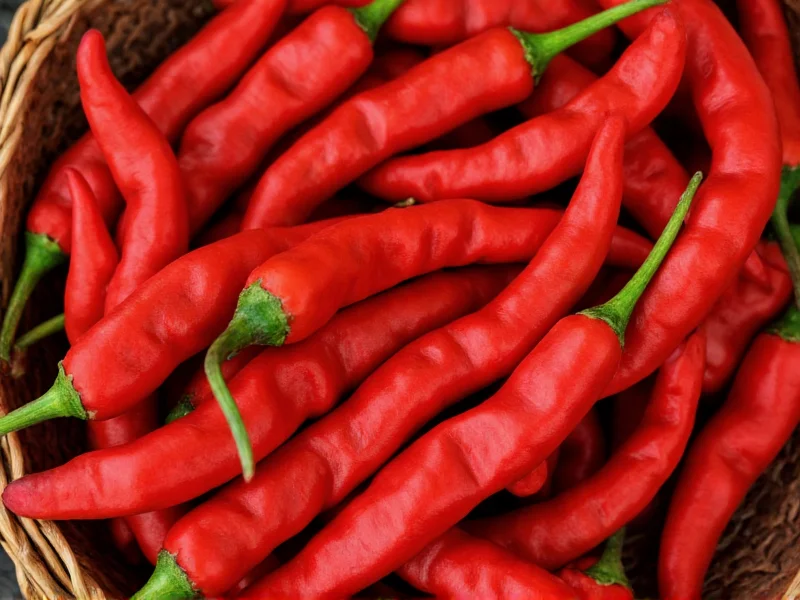Understanding exactly how hot is the cayenne pepper requires examining both scientific measurement and practical culinary implications. The Scoville scale, developed by pharmacist Wilbur Scoville in 1912, remains the standard method for measuring chili pepper heat intensity through capsaicin concentration.
Measuring Pepper Heat: The Science Behind the Burn
Capsaicinoids, particularly capsaicin, are the chemical compounds responsible for the burning sensation we perceive as “heat” in chili peppers. The Scoville Organoleptic Test originally measured heat through human taste panels diluting pepper extracts until the heat became undetectable. Today, high-performance liquid chromatography (HPLC) provides precise capsaicin measurements that are then converted to Scoville Heat Units.
Modern testing reveals that cayenne pepper’s heat level isn't fixed. Several factors influence its actual spiciness:
- Pepper variety - Different cayenne cultivars exhibit varying heat levels
- Growing conditions - Soil composition, climate, and water stress affect capsaicin production
- Ripeness - Fully mature red cayenne peppers tend to be hotter than younger green versions
- Plant position - Peppers growing on outer branches often develop more heat
Cayenne Pepper Heat Compared to Other Common Peppers
| Pepper Type | Scoville Heat Units (SHU) | Heat Comparison to Cayenne |
|---|---|---|
| Bell Pepper | 0 SHU | Not spicy |
| Jalapeño | 2,500-8,000 SHU | 4-12x milder than cayenne |
| Cayenne | 30,000-50,000 SHU | Baseline for comparison |
| Tabasco | 30,000-50,000 SHU | Similar heat level |
| Habanero | 100,000-350,000 SHU | 2-7x hotter than cayenne |
| Ghost Pepper | 800,000-1,041,427 SHU | 16-34x hotter than cayenne |
Practical Implications of Cayenne's Heat Level
When working with cayenne pepper in the kitchen, understanding how many scoville units is cayenne pepper helps determine appropriate usage. Professional chefs and home cooks should consider these practical aspects:
Culinary Applications
Cayenne's medium-hot heat profile makes it versatile for adding noticeable spice without overwhelming other flavors. It works particularly well in:
- Creole and Cajun cuisine where it provides foundational heat
- Dry rubs for meats that benefit from its sharp, immediate heat
- Sauces and hot blends where consistent heat is required
- Preserves and pickling recipes that need moderate spice
Safety Considerations
Handling cayenne pepper requires care due to its significant capsaicin content. Always:
- Wear gloves when processing fresh cayenne peppers
- Avoid touching your face, especially eyes, after handling
- Wash hands thoroughly with soap and water after use
- Start with small amounts in recipes and adjust to taste
Common Misconceptions About Cayenne Heat
Several myths persist about cayenne pepper spiciness measurement that deserve clarification:
- Myth: All cayenne peppers have identical heat levels
Reality: Significant variation exists between individual peppers and growing seasons - Myth: The seeds contain most of the heat
Reality: While seeds do contain capsaicin, the highest concentration exists in the white pith (placenta) surrounding the seeds - Myth: Cooking reduces cayenne's heat significantly
Reality: Capsaicin is heat-stable; cooking distributes but doesn't eliminate the heat
Health Considerations of Cayenne's Heat
The capsaicin that gives cayenne its characteristic burn also provides potential health benefits. Research suggests moderate consumption may:
- Boost metabolism temporarily through thermogenesis
- Provide temporary pain relief through capsaicin’s interaction with pain receptors
- Support cardiovascular health through improved blood flow
- Enhance nutrient absorption, particularly of fat-soluble compounds
However, individuals with sensitive digestive systems should consume cayenne cautiously, as excessive amounts can cause gastrointestinal discomfort. Those with conditions like irritable bowel syndrome or acid reflux may need to limit intake.
Measuring Heat in Your Own Kitchen
While professional testing requires laboratory equipment, you can gauge relative heat when comparing cayenne pepper to other varieties through careful tasting:
- Start with tiny amounts (1/16 teaspoon) of dried cayenne
- Wait 2-3 minutes between samples to allow heat perception to reset
- Use dairy products like milk or yogurt to neutralize excessive heat
- Keep tasting neutralizers like sugar or bread nearby
- Document your observations for future reference
Remember that individual heat perception varies significantly based on genetics, previous exposure to spicy foods, and even current health status.











 浙公网安备
33010002000092号
浙公网安备
33010002000092号 浙B2-20120091-4
浙B2-20120091-4